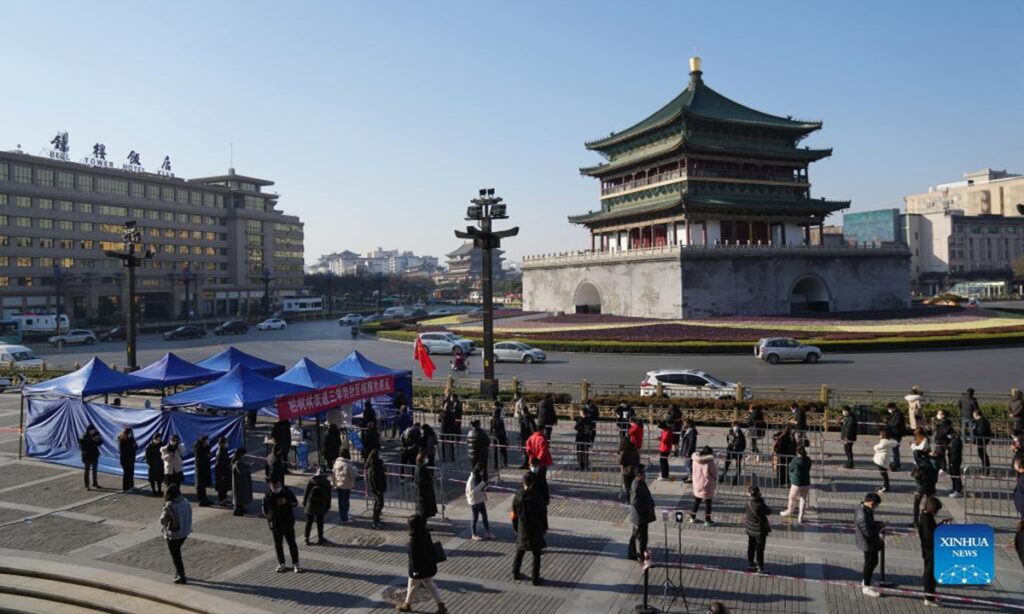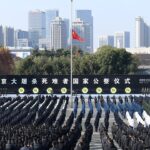Xi’an punishes 26 people in latest COVID-19 outbreak since reporting imported case from Pakistan
As the first day of lockdown in Xi’an, capital city of Northwest China’s Shaanxi Province known for Terracotta Warriors, started Thursday, China has seen three big cities with over 10 million population imposing citywide lockdowns since the pandemic, although the lockdown measures are not as harsh as in Wuhan in early 2020.
Chinese public health experts said in addition to its grim and complicated epidemic situation, several factors led to the necessary decision of lockdown of Xi’an, including the upcoming major holidays of New Year’s Day and Spring Festival, and the Beijing Winter Olympics, and as multiple community transmission chains were unidentified. The city also reported hemorrhagic fever cases which shared a similarity in early stage symptoms with COVID-19, as well as the imported case through an international flight.
Disciplinary authorities in Xi’an have punished 26 people and four local Party organizations and other institutions since December 4 when the city reported an imported case from Pakistan, according to the Central Commission for Discipline Inspection (CCDI) of the Communist Party of China (CPC) on Friday.
Among them, 10 people were punished by Party discipline or dealt with by related organizations for failing to strictly follow protocols, and their chaotic management that resulted in the infection of staff working in a quarantine hotel for overseas travelers. Another four were given administrative punishment for failing to timely control and manage close contacts of confirmed cases.
Starting Thursday, the 13 million residents in Xi’an were required to stay indoors. Only one family member of each household is allowed to leave the house to purchase daily necessities every two days. Other than special needs such as sickness or participating in anti-epidemic work, people are not encouraged to go outside.
The Xi’an Xianyang International Airport cancelled all domestic flights on Thursday. Chinese flight tracking platform Feichangzhun showed that 765 flights scheduled on Thursday were cancelled. Only three international flights at the airport remained as of press time. Trains to multiple cities were also suspended.
Unlike Wuhan which was placed in a strict lockdown early last year, Xi’an said its government departments, companies and organizations were encouraged to have employees work from home.
Since the first case on December 9, Xi’an has reported 234 confirmed cases in two weeks. Wednesday saw 127 newly found positive cases, the highest number in a single day.
The local outbreak has spilled over to at least four other cities, including Yan’an, Xianyang in Shaanxi Province, Dongguan in South China’s Guangdong Province, and Beijing.
Xi’an is the third Chinese city with over 10 million population to impose a COVID-19 lockdown, following Wuhan in early 2020 and Shijiazhuang in North China’s Hebei Province early this year.
On the first day of the lockdown, Xi’an residents said the streets were empty with closed shops and restaurants and few passersby, schools were closed and most of them have started working from home.
Liu Peng, a white-collar worker living in Xi’an, told the Global Times on Thursday that nearby restaurants, shops and barbershops all suspended operations and the residential communities were under closed-loop management.
Liu went to a supermarket to purchase daily necessities in his community, but the shelves were empty. The supermarket owner told him not to worry as the replenishment will be provided in the afternoon.
Local government faced a huge test since Sunday when the city started citywide nucleic acid testing and some residents complained about long lines for testing and a crashed health code system.
But some residents said that the situation improved on Thursday as the government set up more testing stations.
Complicated situation
The epidemic in Xi’an has entered its peak period and will not be brought under control immediately. It’s possible that there will be more cases in the coming days, Lu Hongzhou, head of the Third People’s Hospital of Shenzhen and member of the expert committee of national disease control and prevention, told the Global Times.
The Xi’an government said on Wednesday that hidden transmissions in Xi’an have caused community transmissions and the epidemic has spilled over to other provinces and cities, including Beijing.
A Beijing-based immunologist told the Global Times on condition of anonymity that as a northern megacity, Xi’an has seen its epidemic triggered by imported sources spread to Beijing, which increased the epidemic prevention and control pressure on China for the Beijing Winter Olympics.
The gene sequencing of samples of cases showed the flare-up was caused by the Delta variant, and the virus strain in Xi’an is similar to the one identified in an imported case from Pakistan on December 4.
The raging Omicron variant which spreads faster than Delta has also increased the pressure China is facing in preventing imported cases ahead of the Beijing Winter Olympics.
China’s top respiratory expert Zhong Nanshan said on Thursday that China must not let down its guard as cases related to Omicron will continue to increase globally.
Omicron is wreaking havoc in most Western countries amid the Christmas season with countries like the UK reporting more than 100,000 daily cases for first time since the pandemic, and the US reporting a daily average of 150,000 cases this week. European countries like Germany have imposed measures limiting private gatherings among the vaccinated to a maximum of 10 people before New Year’s Eve.
And for Xi’an, Chinese analysts said that the city faced the dual challenge of cluster COVID-19 infections and the spread of hemorrhagic fever, an acute infectious disease characterized by fever, bleeding and renal damage, which can lead to death.
Health experts said that the early stage symptoms of hemorrhagic fever also include fever and coughing, similar to COVID-19, which could put pressure on early diagnosis or testing.
There have been three transmission chains – “work, family and community”- just over 10 days since the first local case was found in Xi’an. However, we have not figured out the links between different transmission chains, Lu said.
The lockdown doesn’t imply the epidemic in Xi’an is out of control, Yang Zhanqiu, a deputy director of the pathogen biology department at Wuhan University, told the Global Times. He said the epidemic emerges at a critical time when the country is about to experience a traffic surge for the New Year and Spring Festival travel rush, as well as thousands of foreign athletes for the Olympics. So containing the emerging epidemic in a quicker manner is essential for the city and the country.
Experts are confident that China will succeed in quelling the flare-up in Xi’an in about four weeks, as China’s dynamic zero-COVID strategy has been proven to work in that time frame.
Sticking to dynamic zero
Xi’an’s measures are in line with China’s dynamic zero policy, under which local governments introduce precise measures based on an assessment of local epidemic risks, a senior official of the Chinese Center for Disease Control and Prevention told the Global Times on Thursday on condition of anonymity.
However, in reporting the Xi’an outbreak, some Western media again wrote sensational headlines, accusing China’s dynamic zero strategy as overly strict or purely for the Beijing Winter Olympics.
Several media including AFP and BBC claimed Xi’an’s response was seen as China’s efforts to step up measures for Winter Olympics set to open in February, questioning it strictness.
The official stressed that China’s epidemic prevention and control measures were adopted based on China’s dynamic zero COVID-19 strategy, which was not purely for the Winter Olympics, though epidemic prevention was important to the event.
Even after the Winter Olympics, China would stick to its current zero policy if authorities believed it’s not time for China to reopen its international borders, the official said.
The Beijing-based immunologist said that the West has missed their windows for controlling the epidemic in a small scale and their policy of only relying on vaccines proved to be a total failure with Omicron now coming. And to be picky about China’s strategy is the Western media’s strategy to mislead their residents about effective epidemic prevention measures.
But the sharp contrast of cases between China and the West tell the truth, and Western media’s frequent questions will not affect China’s determination to stick to the dynamic zero policy, the immunologist said.
Residents line up for nucleic acid test at a testing site in Xi’an, northwest China’s Shaanxi Province, Dec. 21, 2021.Photo: Xinhua



